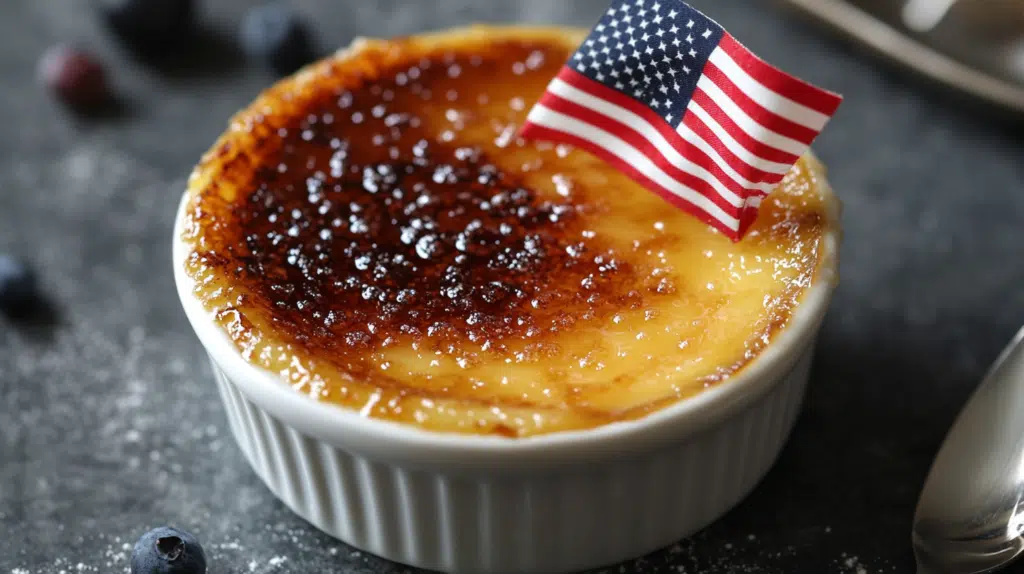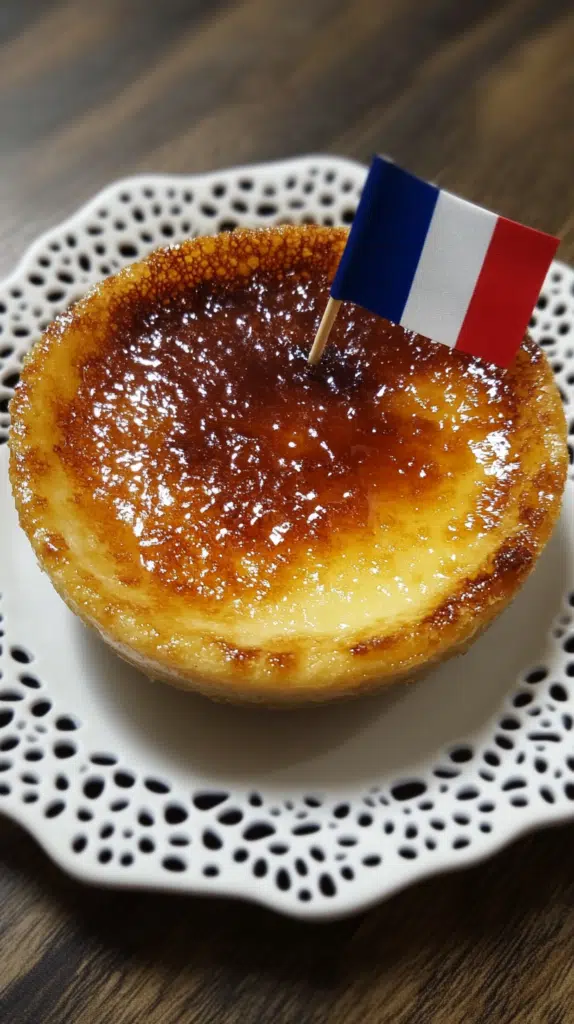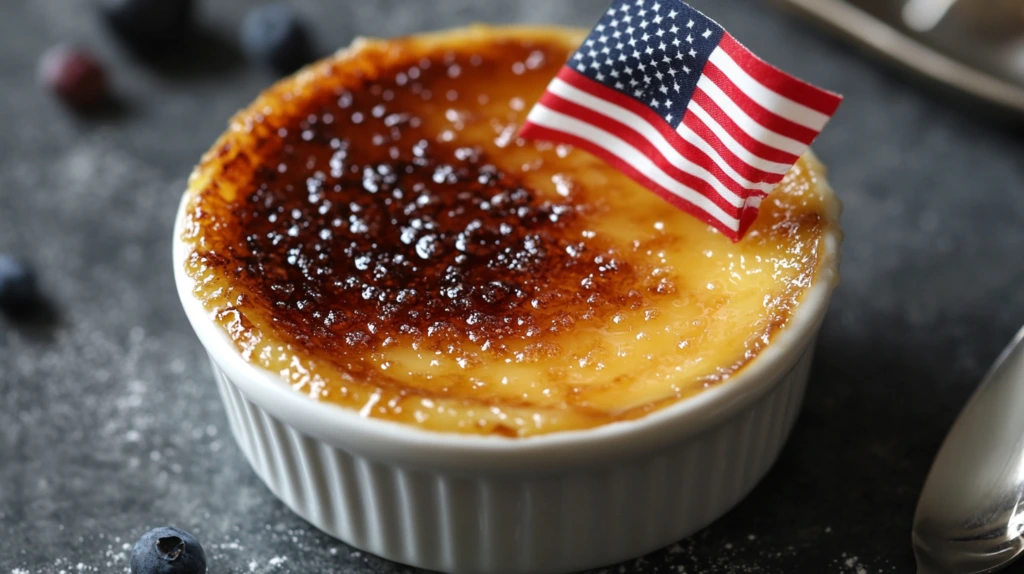
Crème brûlée, with its iconic caramelized sugar crust and creamy custard base, is one of the most cherished desserts globally. While it’s a classic French dish, variations exist across cultures, raising the question: What is the English version of crème brûlée?
This article explores the origins of crème brûlée, its English equivalent, and how custard has played a central role in English desserts.
Origins of Crème Brûlée and its English version
Crème brûlée, an elegant dessert with a silky custard base and a caramelized sugar crust, has an intriguing history rooted in French cuisine but with ties to other European traditions. Understanding its origins explains how this iconic dessert has stood the test of time and evolved over centuries.
Historical Context of French Desserts

French desserts have always been celebrated for their sophistication and balance of flavors. During the 17th century, French chefs perfected custard-based recipes that became the foundation of many beloved desserts, including crème brûlée. The method of combining egg yolks, cream, and sugar to create a smooth, luxurious custard was refined in this era, establishing crème brûlée as a signature treat.
Interestingly, similar desserts emerged in other European countries around the same time. For example:
- Crema Catalana in Spain featured citrus-infused custard with a torched sugar topping.
- In England, Trinity Cream at Trinity College, Cambridge, offered a comparable custard-based dessert.
If you’re curious about crème brûlée’s key ingredients, check out this guide to what crème brûlée is made of.
How Crème Brûlée Evolved Over Time
While its roots lie in European culinary traditions, crème brûlée gained widespread recognition as a French delicacy. By the 19th and 20th centuries, it became synonymous with fine dining, prized for its simplicity and elegance. The caramelized sugar topping, achieved by torching or broiling, was perfected in French kitchens, giving crème brûlée its distinctive textural contrast.
Over time, chefs around the world introduced modern variations by experimenting with flavors such as matcha, lavender, and coconut, while staying true to the traditional recipe. For those wanting to recreate the classic version, try this authentic crème brûlée recipe.
Crème brûlée’s journey from French kitchens to global fame highlights its universal appeal. Its rich history and ability to adapt to evolving tastes ensure it remains a cherished dessert for generations to come. For more culinary inspirations, explore related recipes on Trips Recipes.

What Defines Crème Brûlée?
At its core, crème brûlée is a dessert made of:
- Egg yolks: The foundation for the custard’s creamy texture.
- Heavy cream: Adds richness and smoothness.
- Sugar: Both as a sweetener and for the signature caramelized topping.
- Vanilla or other flavorings: Enhance the custard’s depth.
Its unique feature is the contrasting textures—a brittle caramel top over a smooth custard base. So, to understand more about its components, check out what crème brûlée topping is made of.
The Meaning Behind the Name
The name crème brûlée is not just elegant; it perfectly describes the essence of this classic dessert. Rooted in the French language, the name reflects both its ingredients and the unique preparation method that makes it so iconic.
Literal Translation of “Crème Brûlée”
In French, crème brûlée literally translates to “burnt cream.” The term refers to the dessert’s two defining components:
- Crème: The rich, smooth custard base made from egg yolks, cream, and sugar.
- Brûlée: Derived from the French word “brûler,” meaning “to burn” or “scorch,” which signifies the caramelized sugar topping.6
Additionally, this combination of creamy softness and crisp burnt sugar gives crème brûlée its distinctive character and texture.
For a deeper look at how the dessert achieves this perfect balance, explore this guide on crème brûlée toppings.
Why the Name Reflects Its Preparation
In fact, the preparation of crème brûlée is a culinary art that aligns beautifully with its name. After the custard base is baked to perfection, the final touch is the sugar brûlée—a layer of sugar sprinkled on top and caramelized using a kitchen torch or broiler. This process creates:
- A golden, glass-like crust that cracks satisfyingly when tapped with a spoon.
- A nutty, slightly bitter flavor that contrasts perfectly with the custard’s sweetness.
The term “burnt cream” encapsulates this signature caramelization technique, setting crème brûlée apart from other custard-based desserts. If you’re inspired to try this at home, follow this step-by-step crème brûlée recipe for a foolproof result.
The name crème brûlée beautifully reflects its preparation, celebrating the artistry behind the dessert. From its smooth custard to its burnt sugar topping, the name is as timeless and elegant as the dish itself.
English version of crème brûlée
Trinity Cream: England’s Crème Brûlée
The closest English version of crème brûlée is Trinity Cream. It mirrors crème brûlée’s key elements but is rooted in English culinary tradition. The custard is flavored with nutmeg or citrus, offering a regional twist that sets it apart from its French counterpart.
Custard’s Central Role in English Desserts
Moreover, custard is foundational in English cuisine, appearing in dishes like trifles, steamed puddings, and pies. It showcases the versatility of egg-based desserts and forms the basis for many traditional recipes.
Discover more custard-based inspirations with these sourdough dessert recipes, blending innovation with tradition.
Why It’s Popular in English-Speaking Countries
Also Crème brûlée, with its luxurious texture and crunchy caramelized topping, has become a staple in English-speaking countries. Its enduring popularity can be traced back to the influence of French culinary traditions and its adoption by modern restaurants worldwide.
Influence of French Cuisine
The French have long been revered for their culinary artistry, and crème brûlée is no exception. French cuisine gained prominence in English-speaking countries during the 19th and 20th centuries, particularly among the upper classes and in fine dining establishments. Crème brûlée’s simplicity and elegance made it an appealing addition to menus outside of France, especially in England and the United States.
The dish’s rich custard and signature brûléed sugar crust perfectly align with the refined tastes often associated with French desserts. Over time, it became a symbol of sophistication and indulgence, appealing to those seeking both flavor and elegance in a single dessert.
Learn more about how crème brûlée achieves its perfect caramelized sugar topping in this detailed guide on crème brûlée toppings.
Adoption by Modern Restaurants
Of course, Modern restaurants have played a significant role in cementing crème brûlée’s popularity in English-speaking countries. Its ability to blend simplicity with luxury makes it an ideal dessert for high-end dining experiences. Key reasons for its adoption include:
- Presentation Appeal: Individual servings in ramekins with a golden caramelized crust make it visually stunning.
- Ease of Preparation: Despite its sophisticated appearance, crème brûlée is straightforward to prepare, allowing chefs to add it to menus effortlessly.
- Versatility: Chefs can experiment with flavors like vanilla bean, chocolate, or matcha, offering unique variations while maintaining the dish’s core identity.
If you’re looking to try your hand at this classic dessert, explore this step-by-step crème brûlée recipe for inspiration.
Crème brûlée’s popularity in English-speaking countries stems from the timeless appeal of French cuisine and its widespread adoption by modern restaurants. Its elegant presentation, rich flavor, and versatility ensure that it remains a beloved dessert on menus around the world.
How English version of crème brûlée Differs from Other Custard Desserts
While crème brûlée is custard-based, it stands out from other desserts like flan or pudding due to its caramelized topping. Here’s how it compares:
- Flan: Features a soft custard with a liquid caramel sauce.
- Pudding: Lighter and often starch-based, lacking the richness of crème brûlée.
- Traditional Custards: Focus on creamy texture without additional toppings.
To explore how these desserts differ further, see this comparison between crème brûlée and custard.
English Versions: How It’s Named and Adapted
Crème brûlée, while deeply rooted in French culinary tradition, has inspired English versions with unique names and adaptations. The dish’s core elements remain the same, but its presentation, preparation, and naming often reflect local preferences and creativity.
Simplifications in Naming
Basically, In English-speaking countries, crème brûlée is sometimes referred to as “burnt cream” or “Trinity Cream”. The name “burnt cream” offers a straightforward, literal translation of the French term, highlighting the dessert’s caramelized sugar topping.
One notable English version, Trinity Cream, dates back to the 17th century at Trinity College, Cambridge. This early adaptation mirrors the French original but sometimes includes subtle English touches like:
- Hints of nutmeg for warmth.
- A focus on traditional custard-making techniques.
Learn more about the core custard components of crème brûlée and its variations in this guide to what crème brûlée is made of.
Regional Adaptations and Variations
Although the traditional French crème brûlée remains popular, chefs and home cooks across English-speaking regions have adapted the recipe to reflect local ingredients and tastes. Some notable variations include:
- Lemon Burnt Cream: A British twist that incorporates lemon zest for a bright, citrusy flavor.
- Treacle Cream: Inspired by traditional English puddings, this version includes treacle or golden syrup for a deeper sweetness.
- Coconut Crème Brûlée: Popular in tropical regions, this version replaces heavy cream with coconut milk, adding a light, exotic flavor.
For those exploring custard-based desserts, discover innovative ideas with these sourdough dessert recipes that showcase custard’s versatility.
By simplifying the name and experimenting with regional flavors, English-speaking countries have embraced crème brûlée while giving it a unique twist. Whether enjoyed as burnt cream, Trinity Cream, or a modern adaptation, the dish continues to delight dessert lovers with its timeless appeal.
Modern Takes on English version of crème brûlée
Crème brûlée has inspired countless variations, from matcha-infused versions to coconut-based adaptations. Similarly, Trinity Cream and other English custard desserts have evolved to include creative flavors and modern techniques.
For instance, using store-bought custard as a base for crème brûlée is a quick way to enjoy this treat. Learn more with this guide to using store-bought custard for crème brûlée.
FAQs About Crème Brûlée and Its English Version
What is Crème Brûlée Called in England?
In England, crème brûlée is often referred to as Trinity Cream. This name originated at Trinity College, Cambridge, where the dessert was first served in the 17th century. It shares the same custard base and caramelized sugar topping as its French counterpart but sometimes incorporates subtle English flavors like nutmeg or citrus.
For more details on the classic version of crème brûlée, explore this authentic crème brûlée recipe.
Is Crème Anglaise the Same as Crème Brûlée?
No, crème anglaise and crème brûlée are not the same. While both are custard-based, they differ in consistency and preparation:
- Crème Anglaise: A thin, pourable custard often used as a dessert sauce.
- Crème Brûlée: A thicker, baked custard topped with a caramelized sugar crust.
If you’re looking for ways to elevate custard dishes, check out these sourdough dessert recipes that incorporate custard bases.
What Does the French Dessert Crème Brûlée Translate to in English?
The French dessert crème brûlée translates to “burnt cream” in English. This name refers to the brittle caramelized sugar layer that is torched or broiled on top of the creamy custard.
Discover more about its iconic caramelized topping by exploring what crème brûlée topping is made of.
What is a Brûlée in English?
In English, brûlée means “burnt” or “scorched,” derived from the French word “brûler.” It specifically refers to the caramelized sugar layer created by torching or broiling the surface of desserts like crème brûlée.
This simple yet elegant process is what gives crème brûlée its signature crunchy texture and visual appeal.
Conclusion: English version of crème brûlée
Crème brûlée and its English equivalent, Trinity Cream, highlight the universal love for custard-based desserts. Whether you savor the traditional French version or its English adaptation, both desserts showcase the beauty of combining creamy textures with caramelized finishes. For more inspiration, visit Trips Recipes and explore a world of delightful desserts.

